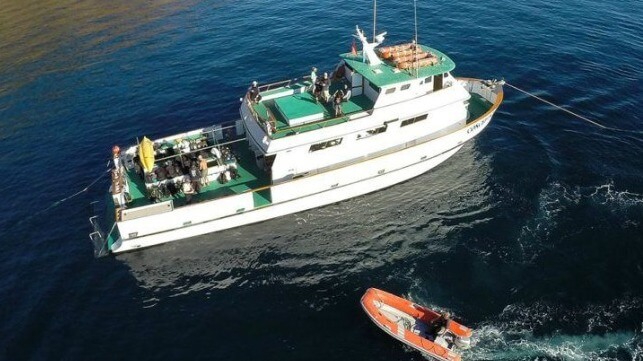After Deadly Dive Boat Fire, USCG Issues New Passenger Vessel Rules

On Monday, the U.S. Coast Guard issued a set of interim rules to fill in the safety gaps highlighted by the fire aboard the dive boat Conception two years ago.
The Conception burned and sank in the early hours of September 2, 2019 off Santa Cruz Island, California. 34 people lost their lives in the accident, putting it among the ranks of the deadliest civilian marine casualties in recent U.S. history. The surviving members of the vessel's crew were berthed on the pilothouse level of the boat, and they were awakened by the fire, not by an alarm. There was no roving watchmember on duty.
Following an investigation, the National Transportation Safety Board (NTSB) concluded that the probable cause was the operator's "failure . . . to provide effective oversight of its vessel and crewmember operations, including requirements to ensure that a roving patrol was maintained, which allowed a fire of unknown cause to grow, undetected." The NTSB determined that other contributing causes were inadequate smoke detection and inadequate emergency escape arrangements. The source of ignition remains unknown, but may have been related to circuit overloading or battery fire from an oversized string of rechargeable devices brought by the passengers.
To address these identified risks, Congress passed legislation requiring the Coast Guard to issue new rules for T-boats and K-boats (other than ferries) on coastwise or ocean routes. The statute requires:
- Firefighting and emergency egress training for crewmembers;
- Interconnected fire detectors, extra extinguishers and firefighting equipment in all occupied spaces;
- Monitoring devices to ensure an awake roving watchstander on vessels with overnight accommodations;
- Extra fire detection and suppression systems in unmanned areas with heat sources;
- At least two independent avenues of escape for all general areas accessible to passengers, along with emergency exit drills;
- and new rules for handling, storage, and operation of Li-Ion batteries and other flammables.
The Coast Guard's interim regulations for these requirements were issued Monday, and they strengthen existing standards and make some retroactive to older boats - for example, fire extinguisher and detection system standards, which were different for vessels from an earlier era. A comment period for the interim rules is now open and can be accessed at https://www.regulations.gov.
Litigation over the Conception casualty is still under way, including a suit that accuses the Coast Guard itself of negligence. The lawsuit, filed in September, cites the US Coast Guard’s role in developing and maintaining safety standards and conducting inspections, and it accuses the service of "wrongful death" for failing to enforce its rules. It notes that the Coast Guard was required to conduct both annual inspections as well as five-year certifications, and that Coast Guard marine inspectors had carried out Conception's annual inspection shortly before the fire.
The Coast Guard has increased its enforcement efforts in the California passenger boat industry, adding more resources for underway presence and compliance checks.
“Our intent with these safety compliance checks is to bridge gaps that were identified following the fire onboard the passenger vessel Conception,” said Rear Admiral Brian Penoyer, the Eleventh District commander, in a statement in September. “We discovered that there are a number of operational requirements that are impossible to verify during a dockside annual inspection.”
